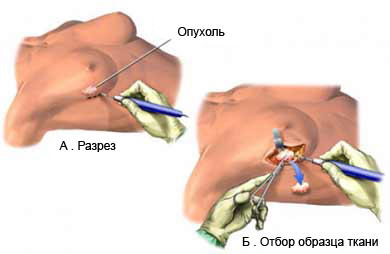Breast Biopsy open – Surgical breast biopsy
Description of surgical breast biopsies
When performing surgical breast biopsy doctor makes her incision and selects a sample of tissue. The sample is sent to a lab for testing.
Causes performing a surgical breast biopsies
The procedure is performed for the study of the suspicious area in the breast. It can be made, If found:
- Tumor;
- Concretion;
- The anomaly of the nipple;
- Discharge from the nipple;
- Abnormal image on the ultrasound or mammography.
A biopsy can identify the area or type of tumor – benign or malignant (cancer).
Possible complications when performing an open breast biopsy
Complications are rare, but no procedure does not guarantee the absence of risk. Before, how to perform open chest biopsy need to know about possible complications, which may include:
- Bleeding;
- Infection;
- Bruise;
- Scarring;
- Tissue damage;
- The deformation of the breast;
- Numbness over area of biopsy.
Some factors, that may increase the risk of complications:
- Obesity;
- Smoking;
- Poor diet;
- Chronic diseases, such as diabetes;
- Coagulation failure.
How is the open breast biopsy?
Preparation for the procedure
The doctor may do the following:
- Perform a physical exam, especially breast exam;
- Order blood tests;
- Conduct a mammogram and / or breast ultrasound.
Before the biopsy
- It may be necessary to stop taking some medicines:
- Aspirin or other anti-inflammatory drugs;
- Blood thinners, eg, clopidogrel (Plaviks) or warfarin;
- The night before, you can eat a light meal. You can not eat or drink anything after midnight;
- On the morning of the biopsy to take a shower. This may be asked to use a special antibacterial soap.
Anesthesia
It can be used in the following types of anesthesia:
- Local anesthesia – It is used only for the area, which is subjected to the procedure;
- General anesthesia – blocks pain and the patient support in sleep. Administered intravenously in the arm or hand.
Description of the procedure of open breast biopsies
There are different methods for selecting the breast tissue:
Open biopsy of the breast
The procedure is performed under general or local anesthesia. Area, which you will be cleaned and disinfected the cut. The doctor makes the area a small incision, then selects a sample of tissue. The incision is closed sutures or staples, bandage.

Localization of the biopsy site using a needle
This technique will be used, If problem areas are deep in the chest, but there is a chance to see it with the test, deducing the image on the monitor. Once a problem is found, the doctor inserts a thin wire into the breast, which indicates the location, where a biopsy should be done. Then he makes a small incision in the designated area and removes a sample of tissue.
How long will the procedure?
1-3 o'clock
Will it hurt during the open breast biopsies?
The patient may feel chest pain after biopsy. The doctor will prescribe painkillers.
Care after the procedure, open biopsy of the breast
When you return home, you need to perform the following actions, to ensure the normal recovery:
- We need to take pain medication as directed by a doctor;
- To reduce discomfort, You can apply a warm compress or a heating pad to the area of biopsy;
- It is necessary to wear a supportive bra;
- It is necessary to ask the doctor, when you need to change bandages;
- It is necessary to limit the exercises for 2-3 weeks after treatment;
- If you have stitches, you can remove them within a week after the procedure;
- Be sure to follow the instructions of the doctor.
The test results will be ready in 2-5 days after the biopsy.
It is necessary to go to the hospital in the following cases
- There were signs of infection, including fever and chills;
- Redness, edema, increased pain, bleeding or any discharge from the incision;
- Nausea and / or vomiting, are not tested after receiving the respective drugs, or persist for more than two days after the procedure;
- Pain, which persists even after taking pain;
- Cough, shortness of breath or chest pain;
- Pain and / or swelling in the legs, calves and feet.
